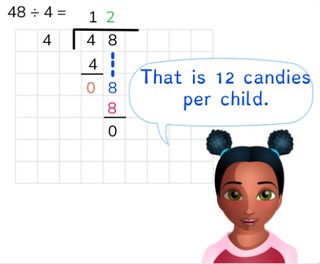
Long division with a number to 100
Students learn long division with a number to 100.



8,000 schools use Gynzy
92,000 teachers use Gynzy
1,600,000 students use Gynzy
General
The students learn long division with a number to 100.
Standards
CCSS.Math.Content.6.NS.B.2
Learning objective
Students will be able to use long division to divide a number to 100.
Introduction
Have the students count the candies and divide them between the children. Have the students solve the division problems.
Instruction
Explain that with long division you put the numbers of the problem next to one another. First you write the divisor on the left. Next you write the dividend to the right and draw a box around it. You put the answer above the box. Show that you first look at the first digit of the dividend. This is the first 6 from 66. You want to take numbers away from the 6. For this you look for the largest number you can take from the table of 3. 6 is in the table of 3, so this is the largest number you can take away from 6. Emphasize that to help with this you can write out a row for the table of 3. In this way you can quickly see what the largest number is that you can use. In this case the largest number is: 2 × 3 = 6. Under 6, write the number 6 and subtract them from one another. You write the answer (0) underneath. You write the 2, from 2 × 3, on top of the box as part of your answer. 0 is not in the table of 3, so you look at the next number. Write the (second) 6 from 66 next to the 0. Now look again what the largest number is that you can take away. That is 2 × 3 = 6. Write the 6 under the second 6 in the problem and subtract. You now have 0 left over. You write the 2 from 2 × 3 next to the 2 in the answer. So now your answer is 22. Next you can practice solving the problem 92 ÷ 4. You can remove the cover to show the intermediate steps. Now have the students solve the following two problems on their own using long division. After this, explain that you can also use long division to solve problems with larger numbers like in the problem 96 ÷ 16. First you are going to take numbers away from the first number 9. But 9 is actually smaller than 16 and is therefore not in the table of 16. So you take the 6 along and see what the largest number is that you can take away from 96. When you look at the helping row you can see that you can take away 5 x 16 = 80. Write the 80 under the 96 and subtract the two numbers. Write the answer (16) underneath. Write the 5 on top of the box. The largest number that can be taken away now is 1 x 16 = 16. Write the 16 under the 16 and subtract. Write the answer (0) underneath. Because both steps were calculated with ones values (5 x 16 and 1 x 16) you add the 5 and the together. Your answer is now 6. Next you can practice solving the problem 78 ÷ 13 = together with the students. You can remove the cover to show the helping row. Now have the students solve the following two problems using long division.
Check whether the students can use long division to divide a number to 100 by asking the following question:
- What steps do you follow to solve the problem 48 ÷ 3 using long division?
Quiz
The students test their understanding of long division with a number to 100 through ten exercises. In these exercises the abstract problems are provided, and the students may use scrap paper to write out the problem and solve it using long division.
Closing
Discuss once again the importance of being able to divide using long division with a number to 100. As a closing activity, have the students solve for the numbers that belong where the splotches of paint are. Discuss the strategy of solving the problem as a group.
Teaching tips
Have students that have difficulty with long division first write out the table before they start a division problem. Break the problem down into more steps than 2, to show how you can divide the number in pieces.
The online teaching platform for interactive whiteboards and displays in schools
Save time building lessons
Manage the classroom more efficiently
Increase student engagement
Discover more!
About Gynzy
Gynzy is an online teaching platform for interactive whiteboards and displays in schools.
With a focus on elementary education, Gynzy’s Whiteboard, digital tools, and activities make it easy for teachers to save time building lessons, increase student engagement, and make classroom management more efficient.



